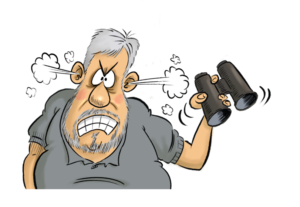This article first appeared in the March 2021 edition of Birdwatching magazine
I want to talk about what goes on in the smallest room in the house (mind you the way they build homes these days that could be any of them!) In the UK alone, we use 1.5 million tonnes of toilet tissue annually. That’s 127 rolls per person. Two and a half rolls a week, each! What is more, the amount of recycled paper used by the top brands has dropped in the last decade from over 30% to under 25%. The leading brand (think puppies) actually dropped a product using a mix of recycled paper and bamboo, at a time when virgin forests are going down the toilet. Pure wood pulp uses more chemicals than recycled despite what people think about bleach.
Only 30% of the world uses toilet paper as there are many hygienic alternatives… perhaps we should be adopting those other ways. Bidets and their equivalents are also far better for the environment as it’s just our waste that has to be dealt with as sewage, not all those pulped trees.
If we are not ready for that, paper can be made from non-forest sources like hemp, bamboo or kenaf which offer a more sustainable alternative to paper made from wood pulp. Choosing tree-free paper does directly conserve the environment somewhat and indirectly protects it a lot. Non-wood fibres have the advantage that they require less energy than wood fibres because they can be mechanically pulped.
The Giant Panda’s favourite food can be distilled in a similar way to sugarcane, making alcohol for industrial use and leaving fibre for paper-making. Its cultivation requires a moderate investment compared to forestry with a much faster turnaround time. Bambusa Vulgaris reaches a height of 16 meters, with a yield per hectare of as much as 560 tons, depending on the amount of water and fertiliser that is used. Some bamboos grow as much as a metre a day and are ready to crop in three years with the stumps re-growing like coppiced wood, so there is no need to replant; a perpetual cropping cycle.
Many bamboos grow on poor soil so are ideal for depleted land rather than land especially cleared for planting, because they need no fertiliser and use less water than all alternatives, they can restore soil and the water table and stabilise cleared hillsides. They have fewer pests than wood and there can also be companion planting to eliminate the need for pesticides. Continually dropping their leaves, they add humous, creating land that can be later used for general agriculture in a cycle of restoration and stabilisation.
What’s more, bamboo has long fibres making it more recyclable as well as cheaper. It produces better papers; strong enough to use in industrial packaging. When it comes to lower body applications bamboo has antibacterial properties, which is very suitable for the many uses we put toilet tissue to.
The world produces close to 500 million tons of paper a year, using 40% of all felled timber. What is stacked high and sold cheap in the supermarkets is costing the earth. 90% of paper fibre comes from trees, despite the fact that paper has only been made that way since the mid-nineteenth century. The bottom line is that we could be using waste fibre from sugarcane, rope making and textiles, along with purpose-grown bamboo and recycled paper.
Companies like ‘Bumboo’ and ‘Who gives a crap’ make toilet rolls from bamboo. Currently, you pay more for smaller rolls. However, if it goes mainstream prices should bottom out, because until then we are getting a bum deal.





